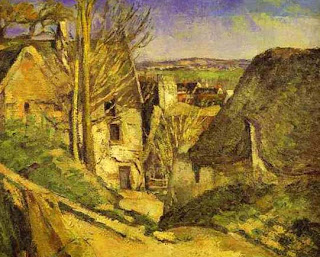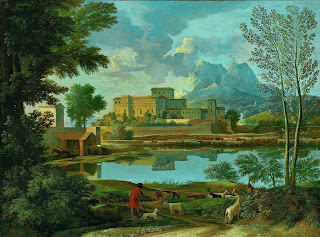Paul Cezanne, The House of the Hanged Man at Auvers, 1872-73
Nicolas Poussin, Landscape with a Calm, 1650-51
Impressionism was an important Art movement of the late nineteenth century in which the painter Paul Cezanne (1839-1906) was a major figure. His influential canon is known to be a corner stone of the transition between late nineteenth century and early twenty century and marks a departure from traditional techniques. The House of the Hanged Man at Auvers was his first work displayed with the impressionists. The impressionists were, at that time, an independent group of modernist artists who sought to create their work apart from the traditional principles.
The critique ranged from moderate to severe and a reviewer left the following comment: “Shall we mention Cezanne, who, by the way, has his own legend? No known jury has ever, even in its dreams, imagined the possibility of accepting a single work by this painter, who came to the Salon carrying his paintings on his back, like Jesus Christ carrying his cross.” [(‘Prouvaire’, 1874, in Moffat, 1966) 2008 The Open University]
The house of the hanged man at Anvers at that time raised unprecedented questions and perceptions about its artistic value. At first sight, I can see that its texture is generally rough. The delineation is not obvious and requires an attentive examination to consider the whole piece. What strikes me the most is the brushwork. Compared with Poussin’s landscape, one could say that there is a dramatic difference in the quality of detail and technique. The most stubborn traditionalists would certainly feel discouraged for taking a close look at it. I see it as less pictorial and more textural as if the artist was in constant search of inspiration from his own works and with his own works in order to find ways to somehow improve the uniqueness of his style. I find it interesting the way he modelled the trees; its shading and vibrant colours (green, brown and yellow) employed with such a textural consistence of tone. There is a tendency to see both the materials on the literal surface and what they are trying to convey. The composition’s foreground is made of the front of a house on the left side that is facing another that appears on the right side covered by a long roof; in between there are other houses and trees. The picture plane is left clear and untouched though the main house, the one that is facing the viewer, is quite distant, whereas the right side house’s roof is closer.
Apart from the artist himself, the qualities of analyses of the Art critics of that time played a fundamental role for its acclaim. And, in between very contrasting opinions, the artist has never ceased to develop its style within its style breaking sentimental barriers with tradition and I think this is a valuable key for Paul Cezanne’s Art.

